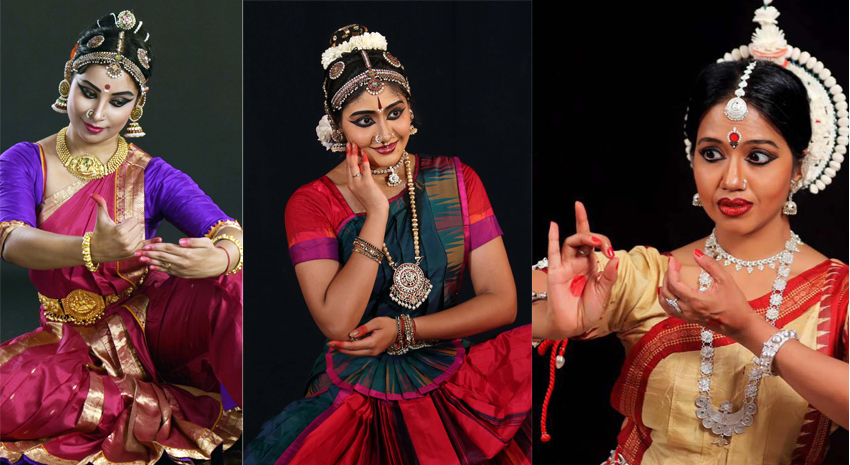The 30th Pandit Durgalal Festival was jointly organized by Uma Dogra’s Samved and NCPA, at Mumbai saw some of the finest artists of the country perform.
Odissi exponent Sharmila Biswas trained by Guru Kelucharan Mohapatra, who is known for extending the boundaries of Odissi with her creative mind, mono acted the story of Surpanaka, Surpanaka the princess. There were aggressive love advances, not as you would imagine, from a male, but from a female- Surpanaka- the sister of Ravana. And there was blood and gore. Rama the Aryan in exile -with whom Surpanaka had fallen in love-was much amused with her aggressive sexuality and immediately declared himself to be a one-woman-man and directed her to brother Lakshmana and thus the brothers did amuse themselves for some time, till she caught on and attacked Sita. But the ‘unchivalrous’ brothers mutilated her. This bloodletting was the cause of Rama conquering Lanka and annihilating Ravana. The enactment of this episode by Sharmila, through dialogues, dance, and other dramatic devices were watched open-mouthed by the audience in a way that immortalized the character of Ravana’s sister. She raised many issues and aroused empathy for the much-wronged persona of Surpanaka.
Kuchipudi dancer Sreelakshmy Govardhanan’s emoting of the nine rasas was woven with stories from Krishna’s life was no less dramatic. The many-layered story of Putana Rakashashi, is a pet subject in every classical dance form of India. She was the emissary of death, sent by Kamsa to kill Krishna, but achieved salvation instead of in the hands of Krishna. Though a demoness the supreme act of motherly feeling was in breastfeeding Krishna. Sreelakshmi breathed into the role in a realistic manner enacting Putana’s emotions. To start with was bhakti sringar and then going onto the other emotional states as the story proceeded. The portrayal of bhibhatsa rasa was rather cathartic, while her surrender leading to salvation was amply and touchingly displayed, giving the audience a chance to share her feelings. The change over from a rakshasi to great beauty, and forgetting her mission and frolicking around and taking part in the joyful activities of Vrindavan. Her momentary impulse not to kill Krishna was touching. Sreelakshmy’s art of story-telling was nuanced. Tarangam which is a pure dance with bhakti bhava performed on the rim of a brass-plate was mesmerizing. The Krishna theme was completed with an astapadi from Jayadeva’s Geet Govinda. A dancer par-excellence, she was ably supported by vocalist Bijeesh.

Nrityagram’s stellar performer Bijayini Satpathy presented three dance compositions Surupa Sen. Srimathi was a pure dance piece/nritta, which is descriptive of a pretty young woman who with maturity is a beautiful and spiritually inclined woman. A sensitively choreographed piece. The piece was a reminder of Lord Byron’s poem ‘She walks in beauty’. The ashtapadi ‘Priye chaarusheele’ was Krishna’s attempt to pacify Radha, who beside herself with hurt feelings needed to meltdown. Krishna knew his way out of every difficult situation. In the many-layered meaning of this astapadi Radha’s preparedness to unite with the supernatural soul of Krishna is effected by Krishna’s submission to her lotus feet. A shloka depicting Shiva’s various forms was superbly executed. She won the hearts of the audience.

One of the leading Bharatanatyam dancers of the times Vaibhav Arekar regaled the audience with his well-researched work depicting Lord Rakhumai Vittal in an abhanga using allarippu bols. He entertained the audience by lucidly and humorously telling the story of Shiva’s meeting with Vishnu, where he spoke about- in the vocabulary of Bharatanatyam- the encounter of Shiva’s snake, which he had used to tie his loincloth and Vishnu’s vahana, Garuda. The snake was so frightened of Garuda, that it fled, leaving Shiva completely disrobed in front of his august guest.’Krishna nee begane baaro’ sobut with a different twist. Vaibhav was the seeker urging the rasikas to do the same. The various stories surrounding Krishna cult was included in the piece. A solo rendition of a padam by Vaibhav was followed by his young students performing Balamurali Krishna’s kuntalavarali tillana as a grand finale with energy and gusto as a fitting finale. It was a scintillating piece. The audience was made to leave their seats hankering for more of such beautiful renditions.
Uma Dogra succeeded in observing the 39th year of Samved’s observance of her guru Pandit Durga Lal’s birth anniversary.










